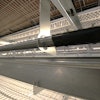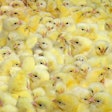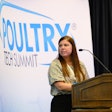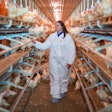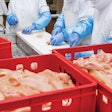
Poultry industry economist Dr. Paul Aho said we are now living in the portal to the post-COVID-19 world, and once we pass through that portal, the global poultry industry could be very different.
Aho, president of Poultry Perspective, delivering the morning keynote address during the 2020 Virtual Poultry Tech Summit on October 20, anticipates that the arrival into a post-COVID world will likely happen in 2022 or 2023.
Chicken consumption will continue to grow
Chicken is presently “the king of meats,” outgrowing pork as the world’s most consumed meat on a per capita basis. Part of that is because of the impacts of African swine fever (ASF) on worldwide pork production, but there are also benefits to chicken that are external to the ASF outbreak.
“(Chicken consumption) tends to grow with or without recessions,” he said, saying it always has a high demand, because it is a low-cost protein that is “acceptable to most religions.”
While demand for farmed fish and alternative proteins is climbing, so is demand for chicken. Aho expects pork demand to rebound in a post-COVID, post-ASF world, but he does not expect it to climb back to the levels it experienced before the ASF outbreak.
Changes within the supply chain
Aho expects there to be more digitalization within every step of the supply chain in a post-COVID world.
He also said the industry’s present mindset of “just in time” in terms of inventory will need to shift to a “just in case” mentality to be prepared for unplanned disruptive events.
He said as consumers become more health-conscious and seek to have more information about the products they consume, “traceability will certainly be required.”
The industry also needs to adopt supply chain strategies and identify alternative sources of supply. It would be unwise to depend on just one country or region for that supply.
Increased automation
The poultry industry’s move toward more automation will continue, and there will be an accelerated technological transformation.
“In many cases, we will be reducing headcount, particularly when people have to stand shoulder-to-shoulder,” Aho said.
Internet companies versus chicken companies
In a post-COVID world, poultry producers will need to quit thinking themselves as chicken companies and instead think of themselves as internet companies in order to be successful.
He cited Uber’s emergence as an example. Cab companies thought of themselves as just that, in which their plan was just to transport passengers from one location to another, with no real online presence or means to do business virtually.
Then, “Uber came along and ate their lunch,” he said. “Every company needs to become an internet company.”
Attend the 2021 Poultry Tech Summit
Join an exclusive international gathering of industry-changing innovators, researchers, entrepreneurs, technology experts, investors and leading poultry producers at the 2021 edition of Poultry Tech Summit on October 31 - November 2 in Atlanta, Georgia. Attendees can expect the same groundbreaking innovation and insightful presentations that made the previous events well-attended with deep dialogue on new prospective solutions and developing technologies.
View our continuing coverage of the coronavirus/COVID-19 pandemic.
Like what you just read? Sign up now for free to receive the Poultry Future Newsletter.

